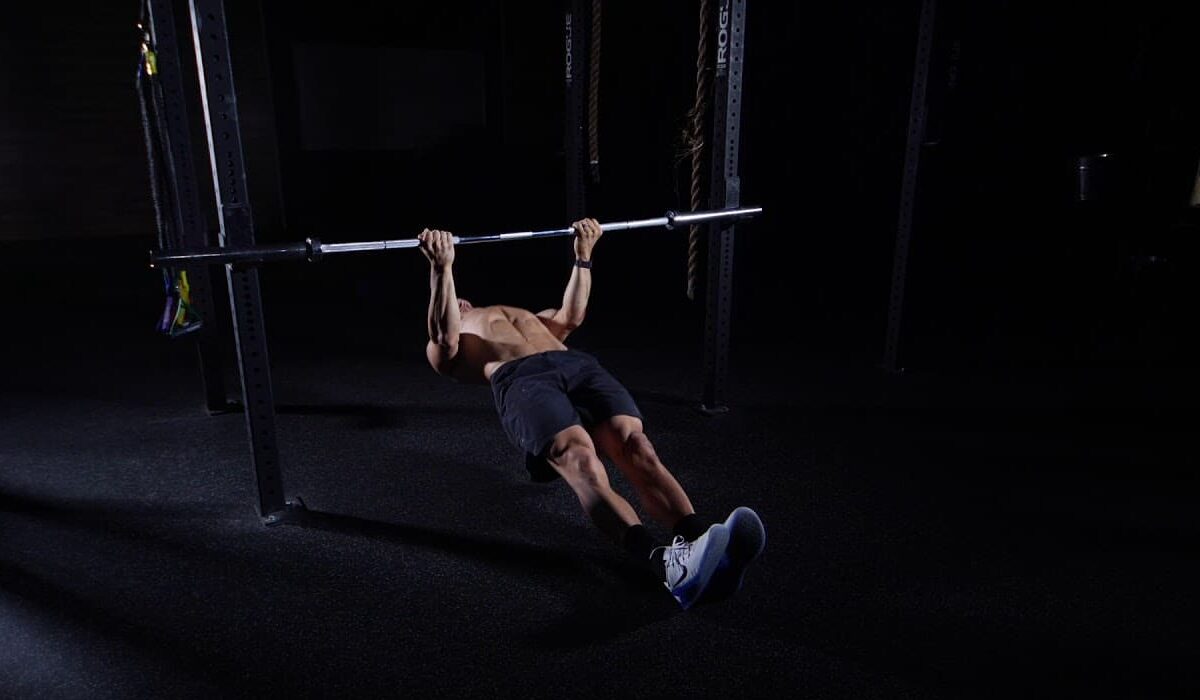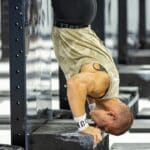The inverted row is one of the best rowing exercises anybody can do. It’s an excellent option for beginners, intermediate, and advanced lifters.
This is a terrific exercise to improve your pulling mechanics, posture, hand grip, and even core muscles.
By the end of this article, you’ll get familiar with the inverted row’s target muscles, tips to improve your technique and all the benefits this movement offers.
Buckle up!
Jump to:
What Is An Inverted Row?
An inverted row is the same as a bodyweight row or an Australian pull-up, as some people call it.
It’s often used as a variation of the bent-over row, which requires more equipment, balance, and attention to technique.
The inverted row is simpler and almost intuitive, and you only need a bar and support to make gains.
And if you don’t have access to a bar or gym equipment, these variations at home may be helpful:
What Muscles Does the Inverted Row Work?
The muscles in our body are often classified as “pulling muscles” and “pushing muscles.”
Although this is somewhat vague, it can rapidly help you understand which muscles are being targeted during a movement.
The inverted row is an upper-body pulling movement, which means that almost every muscle involved in a pulling action will be recruited.
Some of them are:
– Biceps.
– Lattisimus dorsi (lats/dorsal).
– Posterior deltoids.
– Rhomboids.
– Trapezius.
– Wrist flexors.
All of them are responsible for an efficient pulling movement during the inverted row.
Benefits of the Inverted Row
Because the inverted row can adjust in many ways, the benefits are abundant to almost everyone in the fitness community.
You can use a bar, rings, PVC pipes, doorways, and TRX handles.
This variability makes it perfect for bodybuilders, strongmen, weightlifters, or anybody trying to get their first pull-up.
Great Pull-Up Variation For Beginners
Doing your first pull-up is a milestone for many fitness enthusiasts, especially women who reportedly have less upper-body strength than men (1).
A strict pull-up requires you to pull your body weight up using no more than your arms.
The inverted row is a perfect variation since it can remove the weight from your lower limbs by keeping your feet in touch with the floor.
This alternative properly works on the pulling technique and mechanics while building the muscular endurance that will progress to the pull-up.
It can Be Used As A Warm-Up
If you’re advanced enough to knock down multiple pull-ups in a row, warming up with inverted rows will ensure a great workout.
The traditional pull-up is similar to the Australian pull-up in muscle activation, making it a common warm-up option.
Even if you’re not doing pull-ups yet, by increasing the bar’s height, you can get an effective warm-up that suits your training stimulus.
Improve Upper Body Strength And Posture
Posture is the body’s position in space and is controlled by interactions between muscle-skeletal, visual, vestibular, and skin systems (2.)
Although there’s no such thing as a “perfect posture,” it doesn’t mean we shouldn’t strive to keep a healthy one.

Muscles like the neck extensor, trapezius, posterior deltoids, and rhomboids play a crucial role in retracting the shoulder blades and keeping a neutral line from head to heels.
The inverted row can target all these muscles, thus improving the upper body strength and making it easier for the body to keep a firm posture.
Perfect For Upper Body Hypertrophy
Hypertrophy is how muscle cells increase in size in response to external stimuli (3.)
A key ingredient for hypertrophy is mechanical tension.
The more time the muscle spends under mechanical tension, the more it can grow because there will be more muscle fiber recruitment.
This row variation offers enough facility to control the movement throughout the entire range of motion, maximizing the time under tension.
Another benefit is the volume (amount of reps) that you can sustain with a low risk of injury.
This combination makes it a perfect mass-building back exercise independent of your fitness level.
Increases Grip Strength
Increasing the grip strength is a “side effect” of inverted rows. Most pulling exercises contribute to a strong hand grip.
The reason is simple: we need our hands to hold the bar before pulling ourselves up.
It doesn’t matter the grip type; as long as you’re grasping the bar (or anything) with enough brawn, you’ll increase your grip strength over time.
This is terrific news for the elderly population, as grip strength has been proposed as a biomarker of aging (4.)
Easy To Incorporate Into Upper Body Workouts
Inverted rows can be used as warm-ups, main movements, or as a finisher for your workout routines and bodyweight exercises.
The high scalability makes it easier to adapt to other compound exercises and row alternatives like dumbbell rows, bent-over barbell rows, and chest-supported rows.
Depending on the type of training stimulus you’re looking for, even with minimal equipment, you can easily incorporate this excellent upper-body muscle builder into your training routine.
The Proper Technique
Like every exercise, the proper technique should always come before intensity and volume.
It is no different with the inverted row. Although it’s not a complex movement, there are a few elements to master.
Picking The Right Grip Variation
The grip refers to how our hands grasp the bar in the starting position.
Although the most fundamental aspect of the inverted row is the movement itself, the grip variation comes in third place, right after the proper form.
There are four common grip variations:
– Wide grip (outside of shoulder width)
– Narrow grip
– Pronated (overhand grip)
– Supinated (underhand grip)
– Mixed grip (one hand supinated, one hand pronated)
Which Grip Is Better
Each of these alternatives has its benefits, depending on what you want to get out of your regular training routine.
A wide grip focuses more on the posterior deltoids and rhomboids than the lattisimus dorsi (LD.) Reversely, a narrow grip will target more biceps and the lats.
According to Snarr et al. (2017) (5), a pronated grip provided significantly greater activation of the LD than a supinated grip.

Pronated grip.
Mixed and narrow grips are easier to perform for beginners due to the greater involvement of the biceps.
Ultimately, it’s all to your fitness level and workout preference.
Initial Position: Torso & Feet
After deciding on the best grip alternative, let’s move down to the torso and feet placement.
At the starting position, you want to bring your feet together and keep your torso in a straight line with your butt and legs.
Before initiating the movement, your butt should be in the air while holding a contraction, just like your torso and core muscles.
Keep in mind that placing your feet on top of a higher-than-floor surface will increase the difficulty of the movement.
The Ideal Arm Path
The ideal arm path will depend on the grip width and type.
If you’re rowing with a wide grip, focus on pulling your elbows away from each other as you bring your chest close to the bar.
This will direct the tension on the rhomboids and posterior deltoids.
For a regular stance grip and all of the pronated, supinated, and mixed variations, you want to think of pulling your elbows down to your hips.
This won’t happen literally, but the neuro-muscular connection will emphasize the LD, trapezius, and core.
Do Inverted Rows Build Mass?
Yes, they do! With inverted rows, you can spend more time under tension controlling the movement, thus increasing muscle hypertrophy.
Are Inverted Rows Better Than Pull-Ups?
No, they are different and, in many cases, complementary. Both have tremendous benefits for all fitness levels.
How Many Reps Of Inverted Rows Should I Do?
It depends on what type of stimulus you’re looking for. Beginners and intermediate can do 8-15 reps, while advanced lifters can go 20+ with added weight.













